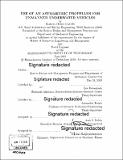| dc.contributor.advisor | Eric Rebentisch and Alexandra Techet. | en_US |
| dc.contributor.author | Carelli, Robert Beltri. | en_US |
| dc.contributor.other | Massachusetts Institute of Technology. Department of Mechanical Engineering. | en_US |
| dc.contributor.other | Massachusetts Institute of Technology. Engineering and Management Program. | en_US |
| dc.contributor.other | System Design and Management Program. | en_US |
| dc.date.accessioned | 2019-10-16T21:32:00Z | |
| dc.date.available | 2019-10-16T21:32:00Z | |
| dc.date.copyright | 2019 | en_US |
| dc.date.issued | 2019 | en_US |
| dc.date.issued | 2019 | en_US |
| dc.identifier.uri | https://hdl.handle.net/1721.1/122609 | |
| dc.description | Thesis: Nav. E., Massachusetts Institute of Technology, Department of Mechanical Engineering, 2019 | en_US |
| dc.description | Thesis: S.M. in Engineering and Management, Massachusetts Institute of Technology, System Design and Management Program, 2019 | en_US |
| dc.description | Cataloged from PDF version of thesis. | en_US |
| dc.description | Includes bibliographical references (page 83). | en_US |
| dc.description.abstract | This thesis describes the development and execution of a test program to determine the suitability of an asymmetric propeller for unmanned underwater vehicles (UUV). The idea to utilize a single blade propeller had been pioneered in the past for aviation as an attempt to generate greater thrust, but was quickly abandoned. Recently, Woods Hole Oceanographic Institute reevaluated the concept for use on a UUV, but for two different objectives. The first was a possible improvement in propulsive efficiency. For UUVs meant to operate for long periods without recharging, any increase in propeller efficiency can result in more time on station. The second object was to allow for an alternate method of steering the UUV. By controlling the speed of the propeller through each revolution, the thrust at any given point can be controlled. This allows for a non-uniformly distributed thrust about the longitudinal axis of the UUV which can be used to steer the UUV. This thesis evaluated the efficiency of using such a propeller. This data was used to determine the suitability for UUVs and in which use cases an asymmetric propeller used for propulsion and steering. Due to issues during testing the control authority provided along a variety of speeds could not be determined for comparison to a traditional propeller and rudder configuration. | en_US |
| dc.description.statementofresponsibility | by Robert Beltri Carelli. | en_US |
| dc.format.extent | 83 pages | en_US |
| dc.language.iso | eng | en_US |
| dc.publisher | Massachusetts Institute of Technology | en_US |
| dc.rights | MIT theses are protected by copyright. They may be viewed, downloaded, or printed from this source but further reproduction or distribution in any format is prohibited without written permission. | en_US |
| dc.rights.uri | http://dspace.mit.edu/handle/1721.1/7582 | en_US |
| dc.subject | Mechanical Engineering. | en_US |
| dc.subject | Engineering and Management Program. | en_US |
| dc.subject | System Design and Management Program. | en_US |
| dc.title | Use of an asymmetric propeller for unmanned underwater vehicles | en_US |
| dc.type | Thesis | en_US |
| dc.description.degree | Nav. E. | en_US |
| dc.description.degree | S.M. in Engineering and Management | en_US |
| dc.contributor.department | Massachusetts Institute of Technology. Department of Mechanical Engineering | en_US |
| dc.contributor.department | Massachusetts Institute of Technology. Engineering and Management Program | en_US |
| dc.identifier.oclc | 1117714019 | en_US |
| dc.description.collection | Nav.E. Massachusetts Institute of Technology, Department of Mechanical Engineering | en_US |
| dc.description.collection | S.M.inEngineeringandManagement Massachusetts Institute of Technology, System Design and Management Program | en_US |
| dspace.imported | 2019-10-16T21:31:58Z | en_US |
| mit.thesis.degree | Master | en_US |
| mit.thesis.department | MechE | en_US |
| mit.thesis.department | SysDes | en_US |
